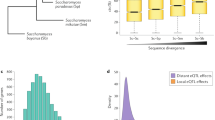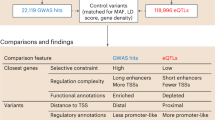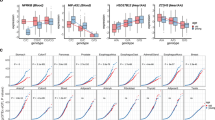Abstract
The development of a multicellular organism and physiological responses require massive coordinated changes in gene expression across several cell and tissue types1,2,3. Polymorphic regions of the genome that influence gene expression levels have been identified by expression quantitative trait locus (eQTL) mapping in many species4,5,6, including loci that have cell-dependent7,8, tissue-dependent9 and age-dependent10 effects. However, there has been no comprehensive characterization of how polymorphisms influence the complex dynamic patterns of gene expression that occur during development and in physiology. Here we describe an efficient experimental design to infer gene expression dynamics from single expression profiles in different genotypes, and apply it to characterize the effect of local (cis) and distant (trans) genetic variation on gene expression at high temporal resolution throughout a 12-hour period of the development of Caenorhabditis elegans. Taking dynamic variation into account identifies >50% more cis-eQTLs, including more than 900 that alter the dynamics of expression during this period. Local sequence polymorphisms extensively affect the timing, rate, magnitude and shape of expression changes. Indeed, many local sequence variants both increase and decrease gene expression, depending on the time-point profiled. Expression dynamics during this 12-hour period are also influenced extensively in trans by distal loci. In particular, several trans loci influence genes with quite diverse dynamic expression patterns, but they do so primarily during a common time interval. Trans loci can therefore act as modifiers of expression during a particular period of development. This study provides the first characterization, to our knowledge, of the effect of local and distant genetic variation on the dynamics of gene expression throughout an extensive time period. Moreover, the approach developed here should facilitate the genetic dissection of other dynamic processes, including potentially development, physiology and disease progression in humans.
This is a preview of subscription content, access via your institution
Access options
Subscribe to this journal
Receive 51 print issues and online access
$199.00 per year
only $3.90 per issue
Buy this article
- Purchase on Springer Link
- Instant access to full article PDF
Prices may be subject to local taxes which are calculated during checkout




Similar content being viewed by others
References
Arbeitman, M. N. et al. Gene expression during the life cycle of Drosophila melanogaster. Science 297, 2270–2275 (2002)
White, K. P., Rifkin, S. A., Hurban, P. & Hogness, D. S. Microarray analysis of Drosophila development during metamorphosis. Science 286, 2179–2184 (1999)
Reinke, V., Gil, I. S., Ward, S. & Kazmer, K. Genome-wide germline-enriched and sex-biased expression profiles in Caenorhabditis elegans. Development 131, 311–323 (2004)
Brem, R. B., Yvert, G., Clinton, R. & Kruglyak, L. Genetic dissection of transcriptional regulation in budding yeast. Science 296, 752–755 (2002)
Schadt, E. E. et al. Genetics of gene expression surveyed in maize, mouse and man. Nature 422, 297–302 (2003)
Rockman, M. V. & Kruglyak, L. Genetics of global gene expression. Nature Rev. Genet. 7, 862–872 (2006)
Gerrits, A. et al. Expression quantitative trait loci are highly sensitive to cellular differentiation state. PLoS Genet. 5, e1000692 (2009)
Ackermann, M., Sikora-Wohlfeld, W. & Beyer, A. Impact of natural genetic variation on gene expression dynamics. PLoS Genet. 9, e1003514 (2013)
Schadt, E. E. et al. Mapping the genetic architecture of gene expression in human liver. PLoS Biol. 6, e107 (2008)
Viñuela, A., Snoek, L. B., Riksen, J. A. G. & Kammenga, J. E. Genome-wide gene expression regulation as a function of genotype and age in C. elegans. Genome Res. 20, 929–937 (2010)
Gutteling, E. W., Riksen, J. A. G., Bakker, J. & Kammenga, J. E. Mapping phenotypic plasticity and genotype-environment interactions affecting life-history traits in Caenorhabditis elegans. Heredity 98, 28–37 (2007)
Rockman, M. V., Skrovanek, S. S. & Kruglyak, L. Selection at linked sites shapes heritable phenotypic variation in C. elegans. Science 330, 372–376 (2010)
Tormene, P., Giorgino, T., Quaglini, S. & Stefanelli, M. Matching incomplete time series with dynamic time warping: an algorithm and an application to post-stroke rehabilitation. Artif. Intell. Med. 45, 11–34 (2009)
Stegle, O., Parts, L., Durbin, R. & Winn, J. A Bayesian framework to account for complex non-genetic factors in gene expression levels greatly increases power in eQTL studies. PLOS Comput. Biol. 6 e1000770 (2010)
Leek, J. T. & Storey, J. D. Capturing heterogeneity in gene expression studies by surrogate variable analysis. PLoS Genet. 3, 1724–1735 (2007)
Fu, J. et al. Unraveling the regulatory mechanisms underlying tissue-dependent genetic variation of gene expression. PLoS Genet. 8, e1002431 (2012)
Fairfax, B. P. et al. Genetics of gene expression in primary immune cells identifies cell type-specific master regulators and roles of HLA alleles. Nature Genet. 44, 502–510 (2012)
Michaelson, J. J., Alberts, R., Schughart, K. & Beyer, A. Data-driven assessment of eQTL mapping methods. BMC Genomics 11, 502 (2010)
Thompson, O. et al. The million mutation project: A new approach to genetics in Caenorhabditis elegans. Genome Res. 23, 1749–1762 (2013)
Spencer, W. C. et al. A spatial and temporal map of C. elegans gene expression. Genome Res. 21, 325–341 (2011)
Rockman, M. V. & Kruglyak, L. Breeding designs for recombinant inbred advanced intercross lines. Genetics 179, 1069–1078 (2008)
Rockman, M. V. & Kruglyak, L. Recombinational landscape and population genomics of Caenorhabditis elegans. PLoS Genet. 5, e1000419 (2009)
Kirienko, N. V. & Fay, D. S. Transcriptome profiling of the C. elegans Rb ortholog reveals diverse developmental roles. Dev. Biol. 305, 674–684 (2007)
Capra, E. J., Skrovanek, S. M. & Kruglyak, L. Comparative developmental expression profiling of two C. elegans isolates. PLoS ONE 3, e4055 (2008)
Ronald, J., Brem, R. B., Whittle, J. & Kruglyak, L. Local regulatory variation in Saccharomyces cerevisiae. PLoS Genet. 1, e25 (2005)
Storey, J. D., Xiao, W., Leek, J. T., Tompkins, R. G. & Davis, R. W. Significance analysis of time course microarray experiments. Proc. Natl Acad. Sci. USA 102, 12837–12842 (2005)
Seidel, H. S., Rockman, M. V. & Kruglyak, L. Widespread genetic incompatibility in C. elegans maintained by balancing selection. Science 319, 589–594 (2008)
Smith, E. N. & Kruglyak, L. Gene-environment interaction in yeast gene expression. PLoS Biol. 6, e83 (2008)
Acknowledgements
This work was funded by ERASysBio+ ERANET ‘GRAPPLE’, an ERC Starting Grant, MICINN BFU2008-00365 and BFU2011- 26206, AGAUR, the EMBO Young Investigator Program, EU Framework 7 project 277899 4DCellFate, and by the EMBL-CRG Systems Biology Program. We thank J. Kammenga, B. Snoek, M. Sterken and F. Supek for discussions and/or comments on the manuscript.
Author information
Authors and Affiliations
Contributions
M.F. performed all analyses. M.F. and B.L. designed analyses and wrote the manuscript.
Corresponding author
Ethics declarations
Competing interests
The authors declare no competing financial interests.
Extended data figures and tables
Extended Data Figure 1 Inferring dynamic expression from individual expression profiles in each genotype and analysing the effect of local regulatory variation on the dynamics.
a, Genes related to oogenesis (red) and spermatogenesis (blue) have high scores on the first and second canonical variates, respectively. b, Canonical correlation analysis correctly sorts the samples in the reference expression time series. Reference data points are sorted by time along a trajectory that mirrors the one formed by RIAILs (Fig. 1) when projected onto the first two canonical variates. Numbers indicate the time in hours after the mid-L3 stage at which each reference sample was prepared. c, PCA on the uncentred RIAIL expression data reveals two outliers that are excluded from further analysis. d, PCA analysis of RIAIL gene expression profiles. Projection of the RIAILs onto first two forms a nonlinear trajectory. The first and second components (comp) explain 37% and 20% of the variance in the RIAILs expression data, respectively. e, Genes related to oogenesis (red) and spermatogenesis (blue) have high scores on the first and second principle components, respectively. f, Projections of the 206 RIAILs ranked by canonical correlation onto the first six canonical variates (i–vi). g, Projections of the reference time series onto the same canonical variates. Dynamic time warping of the RIAIL projections onto the reference projections is used to estimate the physiological age of each RIAIL. h, Projections of the 206 RIAILs onto the first six canonical variates (y axis) versus the final estimated age of each RIAIL (x axis). i, The number of eQTLs detected by a model that only includes local marker without considering time (no time), by a model that includes time and local marker additive effects (additive), and the number of ‘dynamic’ eQTLs; that is, the ones that are best explained by a model that also includes the interaction between local marker and time. j, Classification of the ‘dynamic’ eQTLs into non-mutually exclusive classes. k, Genes with eQTLs are in general biased towards the arms and tips of the chromosomes; the same is also true for genes with ‘dynamic’ eQTLs. Error bars represent 95% binomial confidence intervals. l, Density of polymorphisms in different regions of all genes, genes with no detected eQLTs, genes with any kind of eQTLs, and genes with ‘dynamic’ eQTLs. Intergenic regions are defined as regions between adjacent coding transcripts. 5′ UTR is defined as the region between the transcript start and the translation start site; 3′ UTR is the region between the stop codon and the transcript end. SNP density is defined as the number of SNPs divided by the length of the region of interest. Thus, non-synonymous and synonymous SNP densities are both defined as number of non-synonymous and synonymous SNPs divided by exon length. P values for enrichments were calculated using Fisher’s exact test. Error bars represent 95% binomial confidence intervals.
Extended Data Figure 2 Trans hotspots regulate genes with diverse dynamics.
Left, clustered heat maps of the time-ordered expression of genes regulated by different trans-eQTL hotspots in RIAILs carrying the Bristol (red) or Hawaii (blue) alleles of the trans hotspot. Right, temporal expression profiles of the means of each of the indicated expression clusters when the relevant genomic region carries the Bristol (red) or Hawaii (blue) allele. The numbering of each hotspot follows that in Fig. 4B. Three trans-eQTL hotspots (numbers 5, 6 and 7) have been previously identified.
Extended Data Figure 3 Single maker analysis of trans-eQTLs.
a, The number of target genes per marker is shown for the random forest (black) and single marker analysis (red). Trans hotspots were defined using a Poisson test. According to this test, markers associated with 13 or more eQTLs have a significantly higher number of eQTLs than expected by chance at FDR = 0.1 in the single marker analysis, and so were defined as trans hotspots. Of the top 10 hotspots identified by random forest and presented in the manuscript, 9 are also identified by the single marker analysis. The missing hotspot is number 3 in the middle of chromosome IV, however 21 out of 55 genes (38%) regulated by this hotspot have at least one eQTL in the single marker analysis, and 11 of these are in the same region of chromosome IV as the hotspot, consistent with the random forest analysis. b, To investigate further why the random forest detects more genes as regulated by this hotspot, we calculated the genome-wide correlation between the empirical P values (from the random forest analysis) of the hotspot 3 marker and all other markers. The hotspot 2 marker (red dashed line) has the highest correlation aside from markers that are in linkage disequilibrium with the hotspot 3 marker. c, Marker log odds ratio (LOD) scores of genes in trans hotspot 3 are significantly higher when the genotype of the hotspot 2 marker is included in a linear model. This may contribute to why more genes are detected as regulated by hotspot 3 in the random forest—in which the influence of several markers is taken into account—than in the single marker analysis.
Supplementary information
Supplementary Data
This zipped file contains Supplementary Tables 1-3. Supplementary Table 1 contains high temporal resolution expression profiles of all 15855 detected genes during 12 hours of C. elegans development. Expression values are log2 fold changes compared to a common reference sample and are given for each gene in each of the 206 RIAILs sorted by their age together with the inferred physiological age of each sample. Supplementary Table 2 contains classifications of cis-eQTLs at FDR=0.1. Supplementary Table 3 contains genes regulated by the top 10 trans-eQTL hotspots at FDR=0.1. (ZIP 17454 kb)
Rights and permissions
About this article
Cite this article
Francesconi, M., Lehner, B. The effects of genetic variation on gene expression dynamics during development. Nature 505, 208–211 (2014). https://doi.org/10.1038/nature12772
Received:
Accepted:
Published:
Issue Date:
DOI: https://doi.org/10.1038/nature12772
This article is cited by
-
Identification of candidate genes and chemicals associated with osteoarthritis by transcriptome-wide association study and chemical-gene interaction analysis
Arthritis Research & Therapy (2023)
-
Evolution and function of developmentally dynamic pseudogenes in mammals
Genome Biology (2022)
-
Real age prediction from the transcriptome with RAPToR
Nature Methods (2022)
-
Inferring biological age from the transcriptome with RAPToR
Nature Methods (2022)
-
The decreased expression of GW2 homologous genes contributed to the increased grain width and thousand‑grain weight in wheat-Dasypyrum villosum 6VS·6DL translocation lines
Theoretical and Applied Genetics (2021)
Comments
By submitting a comment you agree to abide by our Terms and Community Guidelines. If you find something abusive or that does not comply with our terms or guidelines please flag it as inappropriate.



